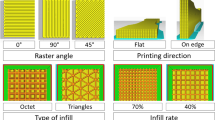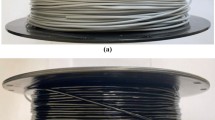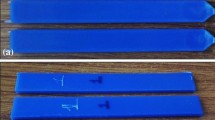Abstract
This research work presents a comparative study of the tensile properties of polylactic acid (PLA) specimens per ASTM D638-14 fabricated by compression molding and 3D printing. PLA pellets from one batch are used in compression molding and filament extrusion for 3D printing. The compression molding process parameters are optimized to obtain an upper limit for mechanical properties of PLA specimens. Design of experiments (DoE) is used to evaluate the effect of processing temperature, pressure, and dwell time on the tensile properties of the specimens. The optimum compression molding trial resulted in slightly higher modulus for tensile specimens compared to 3D printing (3.33 GPa versus 3.22 GPa), while the average tensile strength was almost identical (59.9 MPa). Water absorption test is performed to evaluate moisture absorption of tensile specimens and compare their tensile properties in water saturated condition to the properties of dry specimens. 3D printed specimens showed a significant degradation of their tensile strength and modulus in water saturated condition by 28.4 % and 7.2 %, respectively. On the other hand, the tensile strength of the optimum compression molded specimens was decreased by only 12.0 %, while there was an increase of 14.1 % in tensile modulus.
Similar content being viewed by others
Abbreviations
- WAP:
-
Weighted average property
- σU :
-
Mean tensile strength
- E:
-
Mean modulus
References
A. M. Peterson, Review of acrylonitrile butadiene styrene in fused filament fabrication: a plastics engineering-focused perspective, Additive Manufacturing, 27 (2019) 363–371.
M. Harris, J. Potgieter, R. Archer and K. M. Arif, Effect of material and process specific factors on the strength of printed parts in fused filament fabrication: a review of recent developments, Materials, 12 (10) (2019) 1664.
G. D. Goh, Y. L. Yap, H. K. J. Tan, S. L. Sing, G. L. Goh and W. Y. Yeong, Process-structure-properties in polymer additive manufacturing via material extrusion: a review, Critical Reviews in Solid State and Materials Sciences, 45(2) (2020) 113–133.
D. Zindania and K. Kumar, An insight into additive manufacturing of fiber reinforced polymer composite, International Journal of Lightweight Materials and Manufacture, 2(4) (2019) 267–278.
T. D. Ngo, A. Kashani, G. Imbalzano, K. T. Nguyen and D. Hui, Additive manufacturing (3D printing): a review of materials, methods, applications and challenges, Composites Part B: Engineering, 143 (2018) 172–196.
W. Zhang, C. Cotton, J. Sun, D. Heider, B. Gu, B. Sun and T. W. Chou, Interfacial bonding strength of short carbon fiber/acrylonitrile-butadiene styrene composites fabricated by fused deposition modeling, Composites Part B: Engineering, 137 (2018) 51–59.
R. T. L. Ferreira, I. C. Amatte, T. A. Dutra and D. Bürger, Experimental characterization and micrography of 3D printed PLA and PLA reinforced with short carbon fibers, Composites Part B: Engineering, 124 (2017) 88–100.
N. Li, Y. Li and S. Liu, Rapid prototyping of continuous carbon fiber reinforced polylactic acid composites by 3D printing, Journal of Materials Processing Technology, 238 (2016) 218–225.
T. R. Tiersch and W. T. Monroe, Three-dimensional printing with polylactic acid (PLA) thermoplastic offers new opportunities for cryobiology, Cryobiology, 73(3) (2016) 396–398.
R. A. Giordano, B. M. Wu, S. W. Borland, L. G. Cima, E. M. Sachs and M. J. Cima, Mechanical properties of dense polylactic acid structures fabricated by three dimensional printing, Journal of Biomaterials Science, Polymer Edition, 8(1) (1996) 63–75.
H. Li and M. A. Huneault, Effect of nucleation and plasticization on the crystallization of poly(lactic acid), Polymer, 48(23) (2007) 6855–6866.
X. Wang, M. Jiang, Z. Zhou, J. Gou and D. Hui, 3D printing of polymer matrix composites: a review and prospective, Composites Part B: Engineering, 110 (2017) 442–458.
Y. Song, Y. Li, W. Song, K. Yee, K. Y. Lee and V. L. Tagarielli, Measurements of the mechanical response of unidirectional 3D-printed PLA, Materials & Design, 123 (2017) 154–164.
D. Popescu, A. Zapciu, C. Amza, F. Baciu and R. Marinescu, FDM process parameters influence over the mechanical properties of polymer specimens: a review, Polymer Testing, 69 (2018) 157–166.
Z. Weng, J. Wang, T. Senthil and L. Wu, Mechanical and thermal properties of ABS/montmorillonite nanocomposites for fused deposition modeling 3D printing, Materials & Design, 102 (2016) 276–283.
A. T. Miller, D. L. Safranski, K. E. Smith, D. G. Sycks, R. E. Guldberg and K. Gall, Fatigue of injection molded and 3D printed polycarbonate urethane in solution, Polymer, 108 (2017) 121–134.
C. Kaynak and S. D. Varsavas, Performance comparison of the 3D-printed and injection-molded PLA and its elastomer blend and fiber composites, Journal of Thermoplastic Composite Materials, 32(4) (2019) 1–20.
J. V. Ecker, A. Haider, I. Burzic, A. Huber, G. Eder and S. Hild, Mechanical properties and water absorption behaviour of PLA and PLA/wood composites prepared by 3D printing and injection moulding, Rapid Prototyping Journal, 25(4) (2019) 672–678.
M. Lay, N. L. N. Thajudin, Z. Ain Abdul Hamid, A. Rusli, M. K. Abdullah and R. K. Shuib, Comparison of physical and mechanical properties of PLA, ABS and nylon 6 fabricated using fused deposition modeling and injection molding, Composites Part B: Engineering, 176 (2019) 107341.
O. S. Carneiro, A. F. Silva and R. Gomes, Fused deposition modeling with polypropylene, Materials & Design, 83 (2015) 768–776.
NatureWorks, Ingeo Biopolymer 4043D Technical Data Sheet, https://www.natureworksllc.com.
ASTM D3418-15, Standard Test Method for Transition Temperatures and Enthalpies of Fusion and Crystallization of Polymers by Differential Scanning Calorimetry, West Conshohocken, PA: ASTM International (2015).
A. Rahimizadeh, J. Kalman, K. Fayazbakhsh and L. Lessard, Recycling of fiberglass wind turbine blades into reinforced filaments for use in additive manufacturing, Composites Part B: Engineering, 175 (2019) 107101.
ISO/ASTM 52921, Standard Terminology for Additive Manufacturing—Coordinate Systems and Test Methodologies (2013) 1–13.
K. Fayazbakhsh, M. Movahedi and J. Kalman, The impact of defects on tensile properties of 3D printed parts manufactured by fused filament fabrication, Materials Today Communications, 18 (2019) 140–148.
ASTM D638-14, Standard Test Method for Tensile Properties of Plastics, ASTM International (West Conshohocken, PA, USA).
X. Zhou, S. J. Hsieh and C. C. Ting, Modelling and estimation of tensile behaviour of polylactic acid parts manufactured by fused deposition modelling using finite element analysis and knowledge-based library, Virtual and Physical Prototyping, 13(3) (2018) 177–190.
B. Rankouhi, S. Javadpour, F. Delfanian and T. Letcher, Failure analysis and mechanical characterization of 3d printed abs with respect to layer thickness and orientation, Journal of Failure Analysis and Prevention, 16(3) (2016) 467–481.
S. Ahn, M. Montero, D. Odell, S. Roundy and P. K. Wright, Anisotropic material properties of fused deposition modeling ABS, Rapid Prototyping Journal, 8(4) (2002) 248–257.
Acknowledgments
The authors would like to acknowledge Dr. Amirmohammad Rahimizadeh who performed DSC testing on PLA pellets for this study.
Author information
Authors and Affiliations
Corresponding author
Additional information
Habiba Bougherara is a Professor of the Department of Mechanical and Industrial Engineering, Ryerson University, Toronto, Canada. She received her Ph.D. in Mechanical Engineering from École Polytechnique Montreal. Her research interests include advanced composite materials, modelling and mechanical characterization, biomaterials and biomechanics.
Rights and permissions
About this article
Cite this article
Chandran, V., Kalman, J., Fayazbakhsh, K. et al. A comparative study of the tensile properties of compression molded and 3D printed PLA specimens in dry and water saturated conditions. J Mech Sci Technol 35, 1977–1985 (2021). https://doi.org/10.1007/s12206-021-0415-5
Received:
Revised:
Accepted:
Published:
Issue Date:
DOI: https://doi.org/10.1007/s12206-021-0415-5




